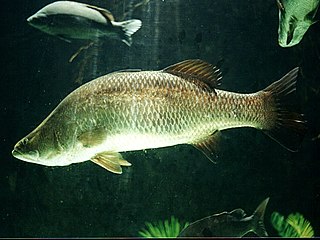
The Barcoo River in western Queensland, Australia rises on the northern slopes of the Warrego Range, flows in a south-westerly direction and unites with the Thomson River to form Cooper Creek. The first European to see the river was Thomas Mitchell in 1846, who named it Victoria River, believing it to be the same river as that named Victoria River by J. C. Wickham in 1839. It was renamed by Edmund Kennedy after a name supplied by local Aborigines.

The grunt sculpin or grunt-fish is a small fish mainly found in the eastern Pacific Ocean. The grunt sculpin generally remains close to shore and is often found in empty giant barnacle shells. It was first identified by Albert Günther in 1874 and was named in honor of naturalist John Richardson. The common name comes from reports that the fish vibrate or "grunt" when held. Its defining feature is its tendency to “hop” along the ocean floor on its orange fins. The short, stout body of the grunt sculpin has a long, small mouth which is adapted for eating smaller prey.

Grunters or tigerperches are ray-finned fishes in the family Terapontidae .. This family is part of the superfamily Percoidea of the order Perciformes.

Haemulidae is a family of fishes in the order Perciformes known commonly as grunts. There are about 133 species in 19 genera. These fish are found in tropical fresh, brackish, and salt waters around the world. They are bottom-feeding predators, and named for their ability to produce sound by grinding their teeth. They also engage in mutualistic relationship with cleaner gobies of genus Elacatinus, allowing them to feed on ectoparasites on their bodies.
Mogurnda clivicola, commonly known as the Flinders Ranges mogurnda, Flinders Ranges purple-spotted gudgeon, Barcoo, or Bulloo mogurnda, is a central Australian gudgeon of the family Eleotridae.
Greenway's grunter is a species of freshwater ray-finned fish, a grunter from the family Terapontidae. It is endemicto the northern part of Western Australia.
Adamson's grunter is a species of freshwater ray-finned fish, a grunter from the family Terapontidae which is endemic to Lake Kutubu in the Kikori River system, Papua New Guinea.
The Fortescue grunter is a species of freshwater ray-finned fish, a grunter from the family Terapontidae. It is endemic to rivers in Western Australia.
Pingalla is a genus of freshwater fish in the family Terapontidae. These fish are native to northern Australia, but one species is also known from New Guinea.

The leathery grunter is a species of fish in the family Terapontidae. It is endemic to Australia. The eggs are fanned and guarded by the male parent.

The small-headed grunter is a species of fish in the family Terapontidae. It is endemic to Australia where it is known only from the upper Burdekin River in Queensland.
Syncomistes is a genus of Australian freshwater ray-finned fish in the family Terapontidae, the grunters.

Scortum barcoo is a species of fish in the family Terapontidae, known by the common names Barcoo grunter and jade perch. It is endemic to Australia, where it can be found in certain major rivers, including the Barcoo River. It is reared in hatcheries.

The sooty grunter, also known by the name black bream, blubberlips, Northern grunter or purple grunter, is a species of freshwater ray-finned fish, a grunter from the family Terapontidae. It inhabits coastal and inland freshwater creeks and rivers of northern Australia.

Microlepidotus is a genus of grunts native to the Pacific coast of North America. The currently recognized species in this genus are:
Bidyanus welchi, commonly known as Welch's grunter, black bream, or silver bream, is a species of freshwater ray-finned fish from the family Terapontidae native to Australia.

Bidyanus is a genus of ray-finned fishes, from the family Terapontidae, the grunters and tigerperches. They are freshwater species which are endemic to Australia.

The Eastern striped grunter is a species of marine ray-finned fish, a grunter from the family Terapontidae. It is found in the Indo-Pacific region where it is found in coastal waters and is an omnivore.

Hephaestus is a genus of freshwater ray-finned fish, grunters from the family Terapontidae.
Scortum neili, Neil's grunter or the Angalarri grunter, is a species of freshwater ray-finned fish, a grunter from the family Terapontidae. It is endemic to the Northern Territory of Australia where it is restricted to the East Baines River and the Angalarri River, which are part of the Victoria River system. The adults are found in small, shady, streams with slow currents over substrates of mixed sand, silt and rock, as well as in deeper rocky pools in gorges. They prefer fresh and clear water at temperatures of 21 and 28 °C with the pH being neural or slightly basic. After spawning the male guard and fan the eggs. This is an uncommon species of grunter which frequently has one or two black blotches which can be placed randiomly as well a number of indistinct pale vertical bars on the flanks, and a silvery stripe just beneath its eyes.












